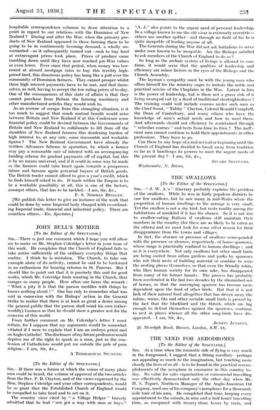THE SWALLOWS
[To the Editor of the SPECTATOR.] SIR,—" J. W. A.'s " itinerary probably explains the problem of the swallows. While he was in fairly populous districts he MN few swallows, but he saw many in mid-Wales where the proportion of human dwellings to the acreage is very small. Yet the swallow is not a shy bird, but nests readily among the habitations of mankind if it has the chance. So it is not due to swallow-eating Italians if swallows still maintain their numbers in the country (for these are as likely to be eaten as the others) and we must look for some other reason for their disappearance from the towns and villages.
In fact, the absence or presence of swallows corresponded with the presence or absence, respectively, of house-sparrows, whose range is practically confined to human dwellings ; and so it is everywhere. Not only swallows but other small birds are being ousted from urban gardens and parks by sparrows who rob their nests of building material or combine to seize the nesting places themselves, so that even the friendly robin, who likes human society for its own sake, has disappeared from many of his former haunts. The process has probably been accelerated in the last two decades by the diminished use of horses, so that the scavenging sparrow has become more dependent upon the food of other birds. But that it is not lack of their natural food altogether that has driven away the robins, wrens, tits and other sociable small birds is proved by the fact that the blackbird and the thrush, which are big enough to defend themselves against the sparrows, continue to nest in places whence all the other song-birds have dis- appeared.--- I am, Sir, &e.,
JENKLN JENKINS.
20 Meredyth Road, Barnes, London, S.11'.13.
































 Previous page
Previous page